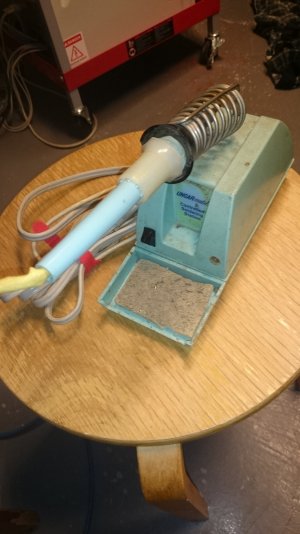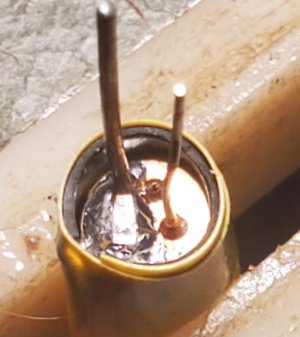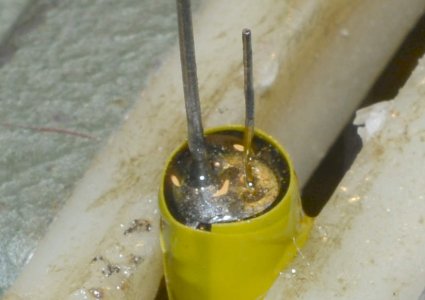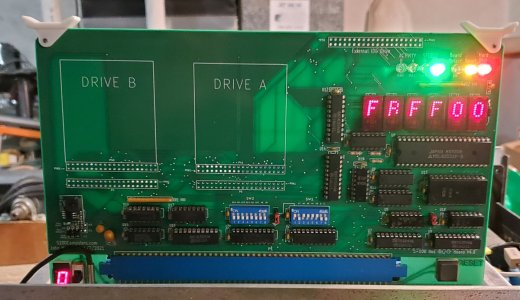I recall the punch card and a lot of terminals adding up to over 300 users at UofA with disk paging to deal with only 16MB of addressable memory. Now you can get a Raspberry Pi4 with 8GB of memory. That's 500 times as much. But then the FLACC (ALGOL-68) compiler was written in assembler.That was back before bloatware was invented. It had to be compact and efficient then because it had to fit in the available memory.
-
Scam Alert. Members are reminded to NOT send money to buy anything. Don't buy things remote and have it shipped - go get it yourself, pay in person, and take your equipment with you. Scammers have burned people on this forum. Urgency, secrecy, excuses, selling for friend, newish members, FUD, are RED FLAGS. A video conference call is not adequate assurance. Face to face interactions are required. Please report suspicions to the forum admins. Stay Safe - anyone can get scammed.
You are using an out of date browser. It may not display this or other websites correctly.
You should upgrade or use an alternative browser.
You should upgrade or use an alternative browser.
Tales from the S-100 dark side.
- Thread starter jcdammeyer
- Start date
Turns out the cathode was the case so I was able to solder on a new thicker wire. I then built a mold out of tape and plastic and poured in some epoxy. Tomorrow I'll solder on some slightly more flexible wires and attach them to the existing stiffer ones and then give it a try. I'd rather make some sort of clip to hold it in place as opposed to the original glue it in place. Not sure what to do there yet.
Attachments
Final report on the MPI 8" disk drive repair. Dug away some plastic on the track zero slotted connector. Soldered on the broken wire. Built a dam around it with tape and filled the cavity with epoxy. Now it's safe from being knocked around.
Next soldered more flexible red and black wires to the IR LED. Then heatshrink around each of those. And then larger diameter heatshrink around both. Bend at right angles and connect to original wires, now a bit shorter to deal with the new wires. Hot melt to hold the sensor and the wires in place.
End result is:
Yahoo! It works again.

Next soldered more flexible red and black wires to the IR LED. Then heatshrink around each of those. And then larger diameter heatshrink around both. Bend at right angles and connect to original wires, now a bit shorter to deal with the new wires. Hot melt to hold the sensor and the wires in place.
End result is:
Code:
D)isk, T)track, S)ector, B)locksize, R)ead, W)rite, V)iew, F)ormat, E)xit -->r
Read command....
Track = 0 Sector = 2 Blocksize = 128
CORRECT? (Y/N)y
Reading disk drive
Disk sector size is -->128
D)isk, T)track, S)ector, B)locksize, R)ead, W)rite, V)iew, F)ormat, E)xit -->v
0000 C3 5C E7 C3 58 E7 7F 00 20 20 20 20 20 20 20 20 >.\..X.. <
0010 20 20 20 20 20 20 20 20 43 4F 50 59 52 49 47 48 > COPYRIGH<
0020 54 20 28 43 29 20 31 39 37 39 2C 20 44 49 47 49 >T (C) 1979, DIGI<
0030 54 41 4C 20 52 45 53 45 41 52 43 48 20 20 00 00 >TAL RESEARCH ..<
0040 00 00 00 00 00 00 00 00 00 00 00 00 00 00 00 00 >................<
0050 00 00 00 00 00 00 00 00 00 00 00 00 00 00 00 00 >................<
0060 00 00 00 00 00 00 00 00 00 00 00 00 00 00 00 00 >................<
0070 00 00 00 00 00 00 00 00 00 00 00 00 00 00 00 00 >................<
D)isk, T)track, S)ector, B)locksize, R)ead, W)rite, V)iew, F)ormat, E)xit -->Yahoo! It works again.
Can't believe that was 21APRIL2022. Went on next to the ERG M68000 S100 system. Got it going after many contortions to create a boot floppy for OS9-68K. Next step is to modify the EPROM monitor to test for a floppy and if not there with an OS then boot from the hard drive.Looking at the curve of the new device it seems like it should be fine. It's on the way from Digikey so I'll find out next week. I likely also have some IR diodes in my parts bin but they are fully plastic and I wanted something with roughly the same beam angle too. We'll see. I don't want to remove the receiver assembly. Even if I scribe lines in the casting, which I'd do before I remove it I'd rather not. And a broken wire on the sender is a pretty big clue to the missing index pulse.
Meanwhile the parts arrived for the S100 board that interfaces to IDE hard drives or Compact Flash cards. Still don't have the compact flash card holders but did write a short program to cycle the displays. Here's a Youtube video.
Testing IDE_CF display.
With this board I can add an IDE hard drive to the dual 8" floppy system that runs CPM-2.2. Likely will upgrade to CP/M 3 since it works better with larger sectors. And the board also uses Compact Flash cards so don't even need a noisy disk drive at all for this. Add a solid state relay to power down the 8" drives and the system would actually be very quiet.
Attachments
This is a good thread. Takes me back to 1976 when the Radio Shack catalog came out. There it was the TRS-80 ..... and I wanted it. I don't remember the exact price but it was around $2500. I do remember my dad saying "NO" and that it cost the same amount as my mom's new Dodge Dart. lol
A few weeks later I talked him into lending me some money. (I think it was $500) From this I bought my first Zilog Z80 chip (I believe it was close to $150, just for the chip) and started to build my first computer from scratch. Slow and steady it actually progressed into an assembly driven unit. (Years later Timex Sinclair came out with a Z80 unit you could build. I wrote a letter to them and they actually sent me a free eprom that had their BASIC language on it) This was wired in and worked very well.
I'm going from memory here but I think the Timex Sinclair had 4k of ram. I was running 16k of ram. All programs had to be typed in and power left on or they were gone. lol. When the Timex Sinclair started to get more popular I started to make memory expansion boards for my friends to bring them up to the 16k of ram. The money I made from this was enough to purchase a TRS-80.
This all happened over a few years, but that first fall day of picking up the Radio Shack catalog is still stuck in my head. I was in grade six, walking home from school.
The trials and errors of learning in this manner have stuck with me for life. Best money my father ever invested in my education.
A few weeks later I talked him into lending me some money. (I think it was $500) From this I bought my first Zilog Z80 chip (I believe it was close to $150, just for the chip) and started to build my first computer from scratch. Slow and steady it actually progressed into an assembly driven unit. (Years later Timex Sinclair came out with a Z80 unit you could build. I wrote a letter to them and they actually sent me a free eprom that had their BASIC language on it) This was wired in and worked very well.
I'm going from memory here but I think the Timex Sinclair had 4k of ram. I was running 16k of ram. All programs had to be typed in and power left on or they were gone. lol. When the Timex Sinclair started to get more popular I started to make memory expansion boards for my friends to bring them up to the 16k of ram. The money I made from this was enough to purchase a TRS-80.
This all happened over a few years, but that first fall day of picking up the Radio Shack catalog is still stuck in my head. I was in grade six, walking home from school.
The trials and errors of learning in this manner have stuck with me for life. Best money my father ever invested in my education.
I was 12 when my dad bought me the Heathkit 6 transistor radio. My first project. Years later, from a suggestion of a friend I'd met in high school band, I was convinced to start the Electronics-10 program in Grade 11. So high school took 4 years instead of 3 just to get that third year of Electronics.The trials and errors of learning in this manner have stuck with me for life. Best money my father ever invested in my education.
From there to CJOI in Wetaskiwin as an evening 'rock jock'. While there I managed in my off time to figure out that RTL logic was overheating in the control cabinet of their automation machine. The skills from High School paid off. From CJOI, to IBM in Edmonton as an OPCE. (Repair Selectric Typewriters). That was the time when it was possible on one salary to afford a one bedroom apartment and put a girlfriend through University.
Of course the danger in doing that is that once they graduate they may not stick around.
The real bug started earlier. My dad had given me a Rocket Crystal radio he had as a kid. From there I built my own crystal radio.
Do you remember Radio Shack had the Free Battery of the month club. I would stop in each month to get my free battery and hound the repair tech that worked in the back. That poor tech took mercy on me and gave me a brand new Ungar Soldering iron and a Heathkit (for some type of electronic tester.....I don't remember what it was for.) I read the instructions, learned to follow directions, solder, understand the circuits. All small steps leading you down a road.
I also did the electronics program in Grades 9,10,11, and 12. I was way ahead of the game. The instructor would let me play in a back room with an amateur radio. Studied the morse code and wrote my amateur radio license.
The electronic magazines back in the day always were a good source of learning also. Lots of cool interesting projects. I grew up in a small town and that made it harder to obtain a lot of the parts I needed. Lots of letter writing and waiting.
I still have that soldering iron today. If I could only count the things it has repaired, designed and built.

Do you remember Radio Shack had the Free Battery of the month club. I would stop in each month to get my free battery and hound the repair tech that worked in the back. That poor tech took mercy on me and gave me a brand new Ungar Soldering iron and a Heathkit (for some type of electronic tester.....I don't remember what it was for.) I read the instructions, learned to follow directions, solder, understand the circuits. All small steps leading you down a road.
I also did the electronics program in Grades 9,10,11, and 12. I was way ahead of the game. The instructor would let me play in a back room with an amateur radio. Studied the morse code and wrote my amateur radio license.
The electronic magazines back in the day always were a good source of learning also. Lots of cool interesting projects. I grew up in a small town and that made it harder to obtain a lot of the parts I needed. Lots of letter writing and waiting.
I still have that soldering iron today. If I could only count the things it has repaired, designed and built.

I have an old Weller WTCP-60 that I still use as the second iron to heat up parts that need to be heated at both ends to come lose.
You're older then you look.....using 8 or 9 relays.
Last edited:
Lost my microprocessor virginity to a Netronics ELF II RCA COSMAC 1802 processor with 256 bytes of RAM. Wirewrapped a 1024 byte add-on memory card. Added a Don Lancaster video interface.
Pestered the local Radio Shack until they hired me. Spent all my spare money buying parts and tools from myself.
As the on-staff computer geek at my store, I made our first TRS80 26-1001 micro sale to my older brother.
Pestered the local Radio Shack until they hired me. Spent all my spare money buying parts and tools from myself.
As the on-staff computer geek at my store, I made our first TRS80 26-1001 micro sale to my older brother.
Last edited:
Radio Shack was my first job too.
Dabbler
ersatz engineer
Perhaps not quite so old... I salvaged the relays and push buttons from F104 (starfighter) navigation equipment the school had around. This happened in 1972.You're older then you look.....
Wasn't too sure where to post this, but this thread seems like a good place.
Sad news. Almost 50 years old now and...
The End of an Era: Zilog Discontinues the Z80 Microprocessor
https://www.allaboutcircuits.com/news/end-of-era-zilog-discontinues-z80-microprocessor/
Sad news. Almost 50 years old now and...
The End of an Era: Zilog Discontinues the Z80 Microprocessor
https://www.allaboutcircuits.com/news/end-of-era-zilog-discontinues-z80-microprocessor/
Wasn't too sure where to post this, but this thread seems like a good place.
Sad news. Almost 50 years old now and...
The End of an Era: Zilog Discontinues the Z80 Microprocessor
https://www.allaboutcircuits.com/news/end-of-era-zilog-discontinues-z80-microprocessor/
Wow...... I didn't even know you could still buy them!
If anyone needs one, I bet I still have a few.....
From the comments on the S100 forum and other places I don't think there will be a shortage for a while.
From the comments on the S100 forum and other places I don't think there will be a shortage for a while.
There is an S100 forum?
I REALLY need someone to kick me HARD for pitching most of my stuff.
gerritv
Gerrit
Zilog headhunted me in the mid 1980's for my skills in using the 8530 Serial Comms chip for synchronous communications (mostly Uniscope protocol but also X25 and others). I didn't want to move to US so didn't accept the offer. I loved their products, well supported by literature and tools.
Other forms of the Z80 live on so no fear of the run ending.
Other forms of the Z80 live on so no fear of the run ending.
gerritv
Gerrit
http://www.s100computers.com/Forum.htm You'll be sorry that you asked. I sold all of my S100 boards, some to the owner of that site.There is an S100 forum?
I REALLY need someone to kick me HARD for pitching most of my stuff.



